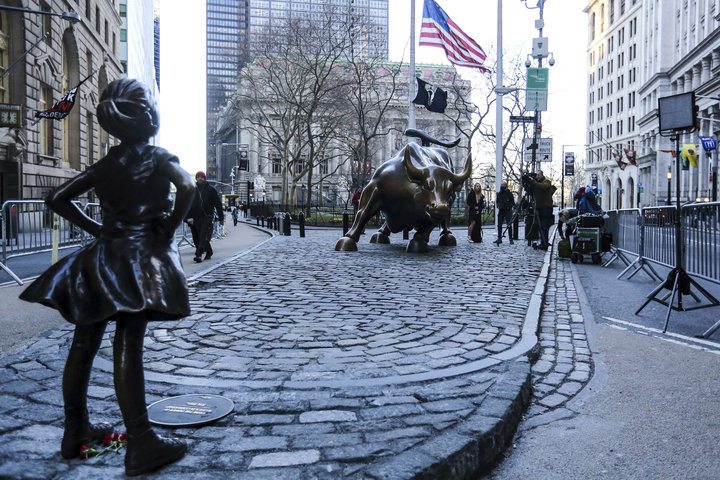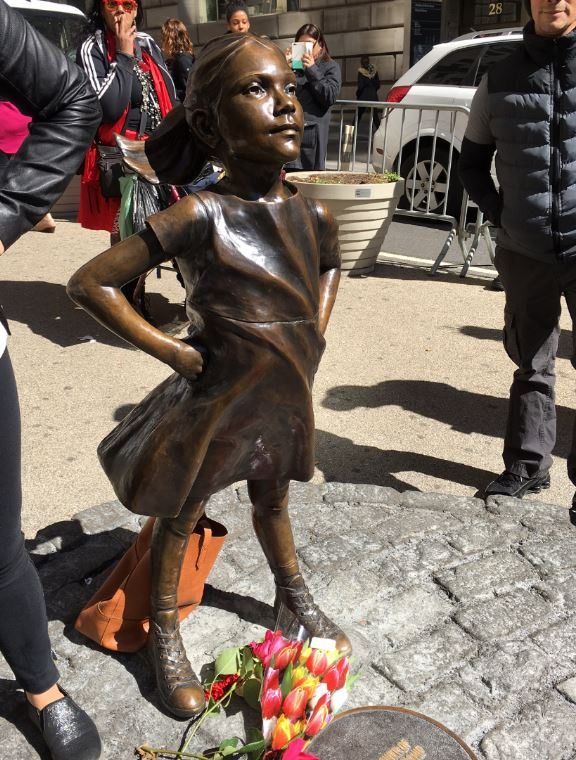
Being in New York on International Women’s Day last week, a surprising event occurred. No, it’s not that Donald Trump renamed the day after his favourite cat, but that a statue appeared next to the Wall Street Bull. A Fearless Girl. The bronze statue is sponsored by State Street and celebrates the idea that women can stand up to anything, even a raging bull.
When I went down there, it was surrounded by tourists and difficult to get a decent pic.
But I did manage to get one or two.
Even one with me in it.
The story of The Fearless Girl is quite interesting, and is written up fully over here at Adweek:
The stunt is meant to symbolize the power of women in leadership. More specifically, it’s part of a campaign by State Street Global Advisors (SSGA) to emphasize that companies with women in top positions perform better financially. For example, a recent study showed that companies with strong female leadership generated a return on equity of 10.1% per year versus 7.4% for those without a critical mass of women at the top, a 36.4% increase of average return on equity.
The statuette is already being talked about as a permanent fixture in New York to symbolise women standing up against the odds, although some have commented that a Fearless Woman might have been a better statue placement. The issue then would be that folks would have argued about placing a woman there, and would also want man and maybe a cow to be placed too.
Whatever. International Women’s Day is an interesting movement.
I often encounter discussions in the financial industry around the representation of women. Generally found in Marketing and Human Resources, there is a distinct lack of women in banking. Go to SIBOS or similar trade shows, and it’s all grey hair and suits. It changes a bit when we talk about Femtech, but even the buzz at Money 2020 is still a lot of hipsters in jeans and beards. In other words, a lack of diversity.
Google recently ran into this issue – Silicon Valley lacks balance of genders (just checkout the Big Bang Theory or Silicon Valley TV shows) – and is doing something about it. In an interesting report in Fortune magazine in January, there is an in-depth review of what Google is up to:
According to the 2016 numbers, some 71% of the company’s roughly 46,000 U.S. employees are male, 57% of the company’s U.S. employees are white, and the vast majority of technology jobs and leadership positions are held by men.
Generally, I think it’s interesting that yes, we do think differently. When the global financial crisis hit almost a decade ago – yes, time flies – there were lots of reports about the idea that there wouldn’t have been a crisis if banks were run by women. The testosterone fuelled trading rooms and egotistical headstrong male dominated world of banking just got too big for itself. A female-led financial world wouldn’t have sent itself over the cliff.
Who knows, but what we do know is the diversity and equality in banking and finance is becoming more noticeable as something that is being addressed. Bloomberg makes this report quite interesting. I found a nice report in their reception last week, unavailable generally online, that has a world map of women in finance and how they’re represented. The editor, Alison Ciaccio, introduces the report as follows:
Research is backing up what many of us might have already assumed: more women often lead to better results. In our look for the best place to be a women in finance, we find that diversity has become not just an option but a necessity especially as most of the world is far from reaching gender parity.
It is true that some countries are making strides. Take Poland, where its comparatively narrow 7 percent gender wage gap could close within the next decade. Yet there are others that are struggling to make a dent: Korea still has a whopping 36 percent gender pay divide.
Nordic countries continue to come out on top in the pursuit of gender equality. Norway has the highest percentage of females on its boards at 39.7 percent, compared with 18.5 percent globally. While Europe is progressing farther than most other regions with its share of female board members, women in the U.S. have gained a much larger percentage of executive positions.
It’s an interesting brief and report. Well worth a read and shame it’s not online.
Meantime, if you really want to see what women think about technology in finance, I cannot commend more the fantastic FemTech Leaders interviews conducted by my good friend Sam Maule. Enjoy.
Chris M Skinner
Chris Skinner is best known as an independent commentator on the financial markets through his blog, TheFinanser.com, as author of the bestselling book Digital Bank, and Chair of the European networking forum the Financial Services Club. He has been voted one of the most influential people in banking by The Financial Brand (as well as one of the best blogs), a FinTech Titan (Next Bank), one of the Fintech Leaders you need to follow (City AM, Deluxe and Jax Finance), as well as one of the Top 40 most influential people in financial technology by the Wall Street Journal's Financial News. To learn more click here...





